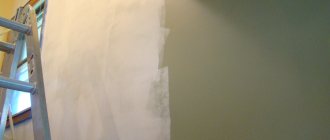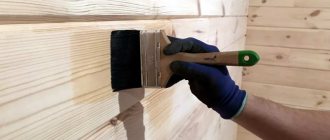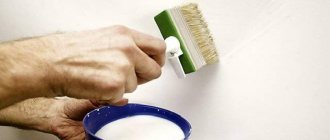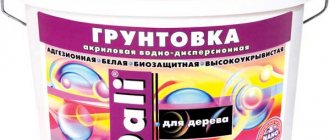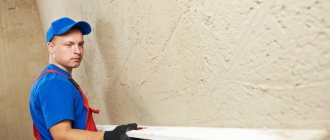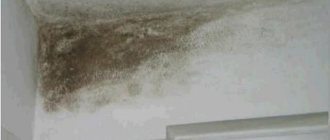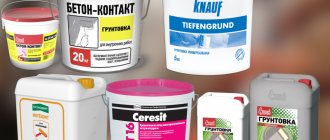Do I need to prime the walls before painting?
Novice finishers do not always understand why preparatory work is carried out. It seems to them that the most important thing is to level the base, then they can safely paint. In fact, this is not entirely true. Indeed, before painting it is very important to level the coating. There should be no differences, cracks or other defects. Therefore, the first step of proper preparation is alignment. It can be made in different ways: drywall, plaster, etc.
At the last stage, finishing putty is most often applied, which will become the base for painting. The next required step is priming. It is necessary because the soil:
- Strengthens the base. It binds weak, porous and loose surfaces into a single whole, making them more durable. Deep penetration formulations cope especially well with this. They are capable of going deeper by 80-100 mm, while conventional preparations do not go deeper than 20-30 mm.
- Improves adhesion or bonding of finishing material and base coat. Thanks to the primer, the paint stays better on the surface, preventing it from peeling and cracking. Moreover, during subsequent repainting it will be easier to prepare the base for work.
- Reduces coating consumption. After treatment, the absorbent properties of the base are significantly reduced. Thanks to this, about a third less composition will be required for finishing.
There are materials with special properties. They can increase the moisture resistance of the surface, prevent mold, etc.
Special primer Tikkurila Otex Akva 0.9 l
1 567
Buy
- Walls
How to prepare walls for finishing
Preparation and necessary tools
The method of applying the mixture is universal and is no different from applying other finishing materials. Immediately before applying the primer, any surface is cleared of the old coating, cleaned, sanded, and also degreased. It is worth noting that the number of approaches to priming walls is always strictly individual, but this must be done at least twice.
To apply the primer you will need:
- roller;
- brush;
- spray;
- capacity.
In each individual case and for each specific task, different tools can be used. For example, you can apply the mixture to a brick surface using a brush, but to smooth walls or plasterboard walls using a roller.
A spray bottle is also an excellent tool for solving such problems, but it is used less often, since after using it it is quite difficult to clean the entire room.
Soil types
The range of primers for walls for painting is varied. Based on the type of base, they can all be divided into several groups.
- Acrylic. Universal, good for wood, concrete, chipboard, plaster, drywall, etc. Can be used for porous coatings, dries in about 5 hours, odorless. Not applicable to metals.
- Glyphthalic. Area of application: metal and wood. It dries in about a day and loses its properties in conditions of high humidity.
- Alkyd. A good option for any wood. After treatment, the fibers swell slightly, which significantly improves adhesion. Dries in about 15 hours.
- Perchlorovinyl. A universal preparation that is used for plasters, metal, plywood, wood, etc. Dries quickly and takes about an hour. It is better to choose it for outdoor use due to its high toxicity.
- Epoxy. A two-component product that significantly increases the adhesion of the base. Used for metal and concrete.
- Mineral with gypsum, cement or lime. Use for concrete or brick. Dries from three hours to a day.
- Aluminum. Used for wood. Additionally protects it from fungal infection.
The optimal and most popular option can be considered universal primers, which are suitable for almost any material. They improve the adhesion of the base and strengthen it, but do not have special characteristics. However, in most cases the latter is not required.
Interior primer Ceresit IN-10, 10 l
667
Buy
Varieties
All alkyd-type primers are divided according to additional materials that complement the composition, which gives them unique qualities:
- Polyvinyl acetate primer is different in that the drying time does not take more than 40 minutes. It is also used exclusively in conjunction with paints.
- Chlorinated PVC compound is intended for outdoor use only. It is needed for plastering concrete walls. Dries in at least 60 minutes.
- Alkyd-urethane primer is a suspension of fillers and coloring agents in a varnish, the components of which are the same components - urethane and alkyd. It is primarily used for metal processing.
Protective priming is actively used to work with metal that has undergone corrosion. When applied, it will prevent new rust from forming in the same places.
Specific characteristics of solutions
If the room has special conditions, you may need to choose a special purpose primer. This could be a primer:
- Antiseptic. It contains an antiseptic that prevents the development of microorganisms. Protects the wall from the appearance of fungus or mold.
- Moisture-proof. Gives the surface water-repellent properties, which is necessary in rooms with high humidity.
- Deep penetration. Strengthens loose and porous substrates. Prevents peeling and cracking of decorative coating.
- Non-contact or adhesive. Improves adhesion to finishing composition. Used for non-absorbent smooth surface.
The packaging of the drug will necessarily contain recommendations for its use. The types of materials with which it is combined and the application conditions are indicated. This information should not be neglected. If the product needs to be prepared for use in some way, this should also be indicated.
Primer for dry and wet areas Axton, 10 l
324
Buy
- Walls
How to prime walls before puttying: simple instructions and tips on choosing a material
General information
Should I prime before painting?
The priming process can be carried out with various compositions - paint, which is prepared with a primer preparation or a concentrate, which is diluted according to the instructions. The solutions will also be marked relative to the surface to which they will be applied (metal, wood or plaster).
Types of solutions
Water-based
Paint such as water-based emulsion is far from the cheapest material for finishing, and therefore preliminary priming of walls makes it possible to significantly save on the consumption of paint and varnish material. The primer composition, which is applied under water-based paint, reduces the hygroscopicity of the base, and this leads to a more uniform distribution of the paint and varnish material on the surface, and also increases the strength of the coating and increases wear life. The primer for the water-based emulsion is applied with a brush, preferably in one layer, which should ideally cover all the unevenness of the walls, but not create uneven accumulations of primer. After the primer composition has completely dried, which takes from 5 to 7 hours, the water-based paint should be applied in two layers.
Silicate
Silicate-type paints are sold dry; to paint mixtures, they should be diluted with water and applied within a short time until the paint loses its properties. For this reason, pre-priming with a silicate base is incredibly important for the speed and quality of the paint job. Special primer compositions make it possible to reduce the toxicity of alkalis contained in silicate-type paints, as well as strengthen mineral surfaces to increase the service life of the paint up to 15 years.
Acrylic
Priming before using acrylic paint has an incredibly important feature - the composition should be applied to highly abrasive surfaces, because it will gradually begin to slide off smooth ones even with paint. For this reason, before applying the primer, the wall surface should be treated with a stiff brush or coarse sandpaper to artificially create grooves and roughness. In turn, the priming solution perfectly fixes the coating particles, and also evens out the adhesive properties and absorbency of the wall surface, which will allow the acrylic paint to lay down evenly, in a durable layer.
Oily
Oil-based paint is one of the best in terms of adhesion, even without applying a preliminary layer of primer. It is this process that will increase the strength of the oil-type coating, and make it smoother and less porous. But often oil paint, which is applied without a primer, will itself act as an unsurpassed material for finishing work, as it adheres well to the surface. When initially applying oil paint, it is not at all necessary to prime the walls before painting. When recoating, it is worth choosing a special “on top of the paint” composition, which will make it possible to save the time needed to remove the old layer.
How long does it take for primer to dry before painting?
This is a very important point that affects the quality and speed of repair work. The manufacturer always informs about the drying time of the solution. However, this is an approximate value, and almost always it is not a specific number that is indicated, but a time period during which the composition should be expected to harden. This happens because the speed of hardening of the product is influenced by various factors:
- Humidity and temperature indoors. 60-80% humidity and +15-20 C are considered optimal. In any case, you should not ventilate the room while the soil is drying. This must be done before applying it. If this rule is not followed, there is a high probability of cracks appearing.
- Quality and type of base. Porous and dry surfaces dry noticeably faster. If for some reason it is necessary to speed up the drying process of the primer, the base should be degreased before applying it.
- Composition of the drug. Products with easily volatile solvents and those with added solids harden faster.
- Number and thickness of applied layers. With each subsequent one, the time it takes for the wall to dry increases.
It is impossible to say exactly how long the primer will dry before painting. This must be determined visually. You should wait the time recommended by the manufacturer, and then touch the primer with your hand. If moisture is felt, painting will have to be postponed.
Instagram obshezhitie_slushaet
To ensure a satisfying result, you only need to paint a flat, primed, dry wall.
- Walls
How to paint walls: a guide to paint selection and application techniques
How to calculate the cost of funds
To determine the approximate amount of material, simple calculations should be made. First, we determine the area that needs to be primed. This can be done by multiplying the height of each wall by its length and then adding the results together. It is important to remember to subtract the area of doors and windows. We should have a certain number of square meters.
Now we determine the rate of consumption of the product. It must be indicated on the packaging. It is rare that in such a case there will be only one number. More often a small fork of values is shown. This is due to the fact that different types of base absorb differently. Knowing what kind of coating we have to work with, we select a number and multiply it by the previously calculated number of squares.
We decide on the number of layers. If you need one, all you have to do is multiply the result by a factor of 1.15 to get some supply of material. In the case when it is supposed to apply two or more layers of primer, we multiply the calculated value by their number, and then by the coefficient. This way we get an approximate amount of primer, which we focus on when purchasing.
Instagram art_remont_stas
The required amount of primer depends on the type of base, the number of its layers, absorbency, etc.
- Decoration Materials
How to paint wet rooms: tips and life hacks
Recommendations from the experts
The basis for a high-quality finishing work result is the use of products from one manufacturer. This helps to avoid unpredictable chemical reactions of different compositions, and moreover, product lines from the same company are designed for joint use, which will make it possible to obtain the planned shade and coverage of the structure.
The principle of a stronger base relative to the applied paint coating is mandatory. This will mean that the primer layer should take on the functions of leveling and adhesion to the walls, and the selected paint will only have a decorative function.
Often, beginners who don’t know whether a primer is needed in principle turn to professional help. To determine the need to use primers, professionals conduct a very simple test - rub the walls with your finger (if a mark remains, then you cannot do without a primer before painting).
Primer on each surface before painting is a step that works to facilitate the progress of future finishing work. Modern priming compositions are ways to strengthen walls, protect them from destruction, chipping, cracking and rust. After applying the product, the layer of paint and varnish material will be distributed much better, which will make it possible to reduce the consumption of paint coatings.
